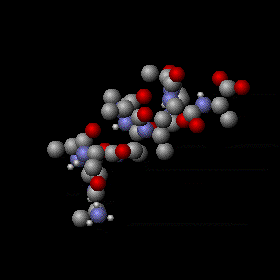Related Research Articles
The number π is a mathematical constant that is the ratio of a circle's circumference to its diameter, approximately equal to 3.14159. The number π appears in many formulae across mathematics and physics. It is an irrational number, meaning that it cannot be expressed exactly as a ratio of two integers, although fractions such as are commonly used to approximate it. Consequently, its decimal representation never ends, nor enters a permanently repeating pattern. It is a transcendental number, meaning that it cannot be a solution of an equation involving only finite sums, products, powers, and integers. The transcendence of π implies that it is impossible to solve the ancient challenge of squaring the circle with a compass and straightedge. The decimal digits of π appear to be randomly distributed, but no proof of this conjecture has been found.
Newton's laws of motion are three laws that describe the relationship between the motion of an object and the forces acting on it. These laws, which provide the basis for Newtonian mechanics, can be paraphrased as follows:
- A body remains at rest, or in motion at a constant speed in a straight line, unless acted upon by a force.
- The net force on a body is equal to the body's acceleration multiplied by its mass or, equivalently, the rate at which the body's momentum changes with time.
- If two bodies exert forces on each other, these forces have the same magnitude but opposite directions.
Agricultural economics is an applied field of economics concerned with the application of economic theory in optimizing the production and distribution of food and fiber products. Agricultural economics began as a branch of economics that specifically dealt with land usage. It focused on maximizing the crop yield while maintaining a good soil ecosystem. Throughout the 20th century the discipline expanded and the current scope of the discipline is much broader. Agricultural economics today includes a variety of applied areas, having considerable overlap with conventional economics. Agricultural economists have made substantial contributions to research in economics, econometrics, development economics, and environmental economics. Agricultural economics influences food policy, agricultural policy, and environmental policy.

A fixed asset, also known as long-lived assets or property, plant and equipment (PP&E), is a term used in accounting for assets and property that may not easily be converted into cash. Fixed assets are different from current assets, such as cash or bank accounts, because the latter are liquid assets. In most cases, only tangible assets are referred to as fixed.
A capital asset is defined as property of any kind held by an assessee, whether connected with their business or profession or not connected with their business or profession. It includes all kinds of property, movable or immovable, tangible or intangible, fixed or circulating. Thus, land and building, plant and machinery, motorcar, furniture, jewellery, route permits, goodwill, tenancy rights, patents, trademarks, shares, debentures, securities, units, mutual funds, zero-coupon bonds etc. are capital assets.
In linear algebra, it is often important to know which vectors have their directions unchanged by a linear transformation. An eigenvector or characteristic vector is such a vector. Thus an eigenvector of a linear transformation is scaled by a constant factor when the linear transformation is applied to it: . The corresponding eigenvalue, characteristic value, or characteristic root is the multiplying factor .
The University of Illinois Press (UIP) is an American university press and is part of the University of Illinois system. Founded in 1918, the press publishes some 120 new books each year, plus 33 scholarly journals, and several electronic projects. Strengths include ethnic and multicultural studies, Lincoln and Illinois history, and the large and diverse series Music in American Life.
Libyssa or Libysa (Λίβισσα), was a town on the north coast of the Sinus Astacenus in ancient Bithynia, on the road from Nicaea to Chalcedon. It was celebrated in antiquity as the place containing the tomb of the Carthaginian general Hannibal. In Pliny's time the town no longer existed, but the spot was noticed only because of the tumulus of Hannibal.

Alfredo il grande is a melodramma serio or serious opera in two acts by Gaetano Donizetti. Andrea Leone Tottola wrote the Italian libretto, which may have been derived from Johann Simon Mayr's 1818 opera of the same name. The opera tells the story of the Anglo-Saxon king Alfred the Great.
Dirty, not clean.

Singolare is an album by Italian singer Mina, originally distributed back to back with album Plurale.

Alfredo Antonio Carlo Buongusto, known by his stage name Fred Bongusto, was an Italian light music singer, songwriter and composer who was very popular in the 1960s and 1970s.

Temperature is a physical quantity that quantitatively expresses the attribute of hotness or coldness. Temperature is measured with a thermometer. It reflects the average kinetic energy of the vibrating and colliding atoms making up a substance.

Atide is an opera in three acts by Josef Mysliveček set to a libretto by Tomaso Stanzani that is based on Greek legends about Atys, an ancient king of Lydia. Stanzani's libretto is based on an earlier libretto by Philippe Quinault that was originally set by Jean-Baptiste Lully as Atys in 1676. The opera Atide belong to the serious type in Italian language referred to as opera seria.
The International Affective Picture System (IAPS) is a database of pictures designed to provide a standardized set of pictures for studying emotion and attention that has been widely used in psychological research. The IAPS was developed by the National Institute of Mental Health Center for Emotion and Attention at the University of Florida. In 2005, the IAPS comprised 956 color photographs ranging from everyday objects and scenes − such as household furniture and landscapes − to extremely rare or exciting scenes − such as mutilated bodies and erotic nudes.

The Lo stadio Tour 2015 is a concert tour by Italian singer-songwriter Tiziano Ferro in promotion of his first compilation album, TZN - The Best of Tiziano Ferro. The news of the tour was announced in October 2014 on the official Facebook profile of the singer. In just 24 hours, 50,000 tickets were sold.

Ermal Meta is an Italian singer and songwriter.

Iotape, Iotapa or Jotape was a small town of ancient Cilicia, in the district called Selenitis, not far from Selinus. It was later assigned to Isauria where it was the seat of a bishop; no longer the seat of a residential bishop, it remains under the name Iotapa in Isauria a titular see of the Roman Catholic Church. It minted coins dating to the emperors Philip and Valerian.
Cyzistra or Kyzistra was a town of ancient Cappadocia, inhabited during Roman and Byzantine times. It was mentioned by Ptolemy.
Nora was a mountain fortress and town of ancient Cappadocia, on the frontiers of Lycaonia. Located at the foot of Mount Taurus, in which Eumenes was for a whole winter besieged by Antigonus (319 BC), before he escaped. In Strabo's time it was called Neroassus or Neroassos (Νηροασσός), and served as a treasury to Sicinus, who was striving to obtain the sovereignty of Cappadocia.
References
- ↑ Farm Credit East DIRTI 5
- ↑ Michigan State University DIRTI 5 (PDF)
- ↑ University of Maryland Extension DIRTI-5, archived from the original on 2015-09-15, retrieved 2020-10-30